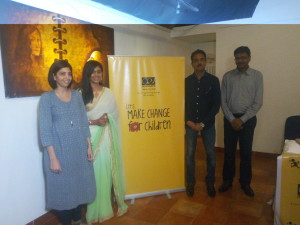Mumbai (GPN) : In its continuing efforts to establish the rights of underprivileged children, Child Rights and You (CRY) on the occasion of World Day Against Child Labour (June 12) unveiled their National Anthem film titled ‘Contrast’ to highlight the grave issue of child labour in India and the importance of education in combating this issue powered by Carnival Cinemas.

National Award Winning Actress Sonali Kulkarni who has partnered with CRY to show her solidarity with combating child labour in India was present at the occasion along with Kreeanne Rabadi, Regional Director (West), CRY; Praveen Singh, Associate General Manager, Development Support and Saurabh Saxena, Chief Operating Officer, Carnival Cinemas.
Close to 1.4 million child labourers in India in the age group of 7-14 years cannot write their names, analysis of Census data by CRY- Child Rights and You reveals. This means one in three child labourers in the said age group are illiterate. This is the grim reality of children who work for more than six months in a year. Even for children who support the family economy by working for less than six months in a year, which is very common in a country like India, the situation is equally, if not more, worse. A shocking 2 million of these marginal workers have compromised their education as well. The situation in Maharashtra is also dismal. 26% of the main working children between 7-14 years (1,30,192 children) are illiterate. Among marginal workers (children who work less than 6 months in a year), 30% of the children between the ages of 5-14 years have their education compromised. For them schooling is not their main non-economic activity.
While the states of Uttar Pradesh, Bihar, Rajasthan, Maharashtra and Madhya Pradesh account for more than 50% of the total child workers in the country, Maharashtra stands out as the fourth most populous state with working children in India.
According to Census 2011, there are 7,27,932 working children in Maharashtra. More than one-third of the child labour in Maharashtra is concentrated in five districts namely Thane, Nashik, Pune, Mumbai suburban and Jalgaon.
There is a high potential of early school leavers and those not learning at school to remain outside the world of employment. These children when they grow remain at a risk of not having secured jobs and thus remain trapped in the intergenerational cycle of poverty and deprivation since their earning potential gets severely deteriorated. An analysis of the educational profile of working adolescents in Maharashtra shows that 56% of working children (between 15-19 years) are either illiterate or have compromised their education.
It is imperative to relook at what we as a nation are investing in our children’s education. We are approaching 6th Anniversary of Right to Free and Compulsory Education and it is crucial that state reviews its strategies in order to reverse this trend.
With the education indicators for these children plummeting, the reasons why we face this challenge need to be addressed. India’s legal framework is based on the assumption that children can work and still be educated. The numbers stated earlier blatantly contradict this assumption and are evidence enough that this needs to change, for main as well as marginal child labourers. In 1992 when India ratified the United Nations Convention on the Rights of the Child (UNCRC), a reservation was made in article 32, wherein the Government of India articulated that it would progressively ban all forms of child labour. Now, after 30 years since the Child Labour Law came into force, India has the opportunity to amend the law in favour of its children.
However, the proposed amendment in the Child Labour law leaves a glaring gap in the prohibition of labour for children under the age of 14. The new law also allows children in this age group to work in family occupations after school hours.
The Census 2011 data for children in labour, states that 6.5 million children in India in the age group of 5 to 14 years work in agriculture and household industries. This makes a staggering 64.1% of child labourers in this age group. CRY’s on ground experience reveals that a large number of children engaged in these occupations are working with their families, thus exempting them from the proposed ban. Allowing children to work in family enterprises is likely to have far reaching implications affecting not only their education and learning outcomes but also their health and overall development.
Ms Kreeanne Rabadi, Regional Director, West, CRY says, “It is discouraging to see a 37% increase in child labourers in the category of 5-9 years in the last ten years. At a time where they should be learning in school and enjoying their childhood, they are compelled to take up the burden of supporting their families. Even if they are attending school, children often work long stretches before and after school hours hence their growth and development gets hampered and the chance that they will drop out is high. They are unable to cope with school, tend to be fatigued and inattentive and are deprived of the right to play and make social connections with their peers.”
Sonali Kulkarni Says,” I am honoured to be part of CRY and given a chance to make a difference. I had led a very rich childhood and I now see that there are so many children who are growing up and as citizens it is our duty to make them feel beautiful about their lives since childhood. Let us wake up to the feelings we have and lets make a difference.”
One in every Three child labourers in India is illiterate : CRY

